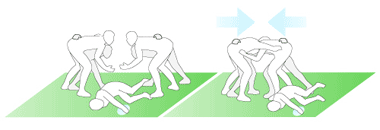The ruck and the maul are important features of any Rugby Union game, each being potent means to score a try. Although often associated with one another, you can tell whether a ruck or a maul will happen simply by looking at the position of the ball at the start. The vital difference between the two is that during a ruck the ball starts on the ground, whereas in a maul the ball begins in the hands of a player. We here at TalkRugbyUnion will be explaining the differences between these 2 techniques as part of our guide on rugby union. Read on to find out more!
The Ruck
A ruck occurs when a player (or players) from each side make contact with each other over the ball, which is on the ground. The aim of the ruck is for the players in each team to move their opponents out of the area, and to manoeuvre the ball toward their respective sides of the ruck so that play can go on from that point. This is achieved by ‘rucking’ the ball to move it from under the bodies of players on the ground.
In Rugby Union terms, rucking is a sort of stamping motion which a player can use if he or she is still standing in a ruck situation. However, if the referee thinks that you are rucking too close to players on the ground, then they will penalise you for dangerous play.
The players should manage to release the ball from a ruck within about five seconds. If this does not happen, the referee will award a scrum to the team that seemed to be making the most progress in the ruck. An example can be seen here.
Because of the strength of many rugby players, injuries can happen if both sides don’t stick to the rules and the referee’s decisions. This is why it is so important to follow some basic pointers which will help everyone to enjoy a game safely:
- Players involved in a ruck should try to stay standing.
- If the player in possession of the ball does fall, they must make sure to let go of the ball as soon as they reach the ground. If they attempt to hold onto the ball so that the other team can’t get to it, the referee will award a penalty.
The ruck and the maul are also similar because they share certain rules:
- Everyone taking part in the ruck/maul must keep their heads. and shoulders higher than their hips.
- No player is allowed to jump on top of the ruck/maul.
- No player should enter from an off-side position. You can tell whether you are off-side or not, as the off-side line is marked by the backmost foot of the team-mate positioned furthest back of the ruck or maul. A player is only allowed to join a ruck or maul from behind this line.
- No player should throw the ball back into the ruck/maul

The Maul
A maul is created when the player handling the ball is held up (but not tackled) by an opposing player, and at least one team-mate of the player in possession of the ball binds to the ball-holder. Therefore a maul needs at least three players, with two of these coming from the same side. In this situation, the ball should still be in a player’s hands, not on the ground, and all of the players involved have to attempt to stay on their feet. Rugby Union rules also say that, to officially be a maul, the players must be heading towards a goal line.
Similarly to a ruck, the maul can be dangerous if players do not abide by the rules. The referee will penalise any unsafe practice, which includes:
- Attempting to create a ruck by ‘bringing down’ or collapsing a maul on purpose.
- Trying to remove opposing players from the maul.
- Not binding properly to the other players once you have joined the maul. Binding means making contact with those on either side of you, and the correct way to do this is to make sure you are touching them with your whole arm – from wrist to shoulder.
